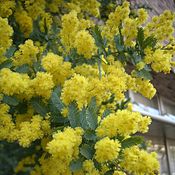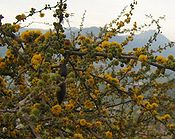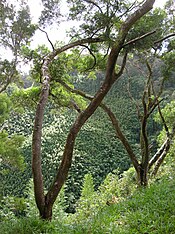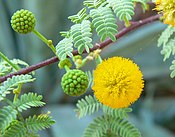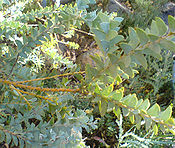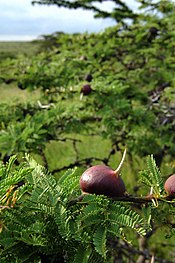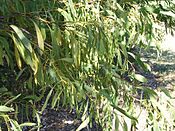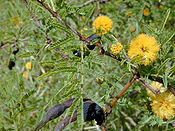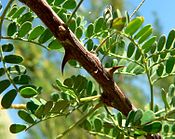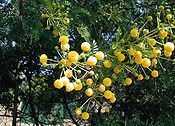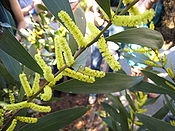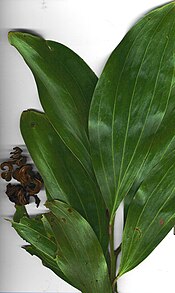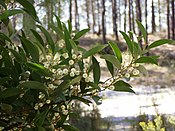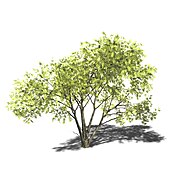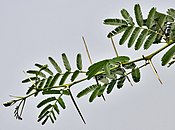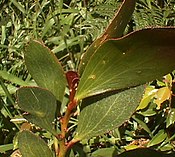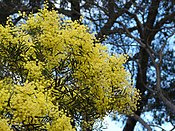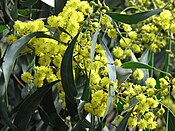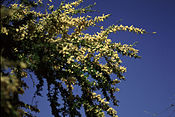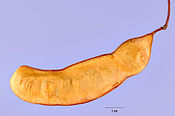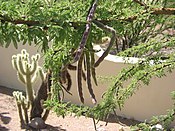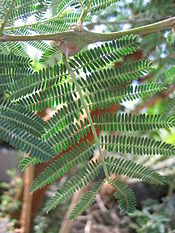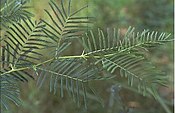This article is a list of Acacia species (sensu lato) that are known to contain psychoactive alkaloids, or are suspected of containing such alkaloids due to being psychoactive. The presence and constitution of alkaloids in nature can be highly variable, due to environmental and genetic factors.
Acacias known to contain psychoactive alkaloids[edit]
| 0.04-0.82% alkaloids in leaves and stems, 0.08% in ripe pods, mostly phenethylamine[1] | |
| DMT in bark (up to 1.6%) and in leaves (0.6-1.0%), young leaves mainly containing tryptamine;[2] 0.72% alkaloids from leaves and stems, mostly tryptamine[3] | |
Acacia burkittii (syn. A. burkittii) |
DMT in bark (0.2-1.2%), 0.1% alkaloids from leaves (mostly NMT);[4] 1.5% alkaloids from leaves and stems, mostly tryptamine[5] |
| β-methyl-phenethylamine (N-methyl-phenethylamine), 2.4% in leaves;[6] 3.2% alkaloids in aerial parts (stems, leaves, flowers) - about 70% was β-methyl-phenethylamine, with smaller amounts of phenethylamine[3] | |
| Published reports of DMT in the leaf[7] derive from a misreading of a paper that found no DMT in leaves of this species.[8] Besides this, there are independent claims of DMT in leaves and bark based on human bioassay,[2] and traces of 5-MeO-DMT, DMT and NMT were tentatively identified by TLC in twigs.[9] Root bark contains alkaloids that were not identified[10] | |
| Dimethyltryptamine active levels in leaf[11][unreliable source?] | |
| Ash used in Pituri.[12] Ether extracts about 2-6% of the dried leaf mass.[13] Not known if psychoactive per se. | |
| 0.028% β-methyl-phenethylamine in leaves,[14] DMT (0.00012-0.00102%) and N-methyltyramine (0.00011-0.005%) in leaves;[15] DMT and 5-MeO-DMT tentatively identified by TLC from roots in one test, not detected in follow up; 5-MeO-DMT tentatively identified by TLC in seeds[9] | |
| Has been claimed to contain tryptamine alkaloids[16] and significant amount of tryptamine in the seeds,[17] but this needs confirmation and supporting information | |
| 5-MeO-DMT tentatively identified in stem bark[9] | |
| 0.02% alkaloids in spring (80% tetrahydroharman, 20% tryptamine), 0.028% autumn (tryptamine) and none in summer, with leaves of Californian plants;[18] traces of DMT and unidentified indoles tentatively detected in seeds[9] | |
| Claimed to be psychoactive,[19] but supporting information is needed. Ash used in pituri[12] | |
| Hordenine, tyramine and N-methyltyramine in leaves;[20] 0.28-0.66% N-methylphenethylamine in leaves. Causes stock intoxications in Texas.[14][21] Claims of amphetamines, mescaline, nicotine and many other alkaloids[22] are suspect[23] | |
| 0.65% alkaloids from leaves and stems, 0.58% from pods and 0.09% from seeds, mostly phenethylamine[1] | |
| Tryptamine and DMT N-oxide from bark[24] | |
| 0.02-0.06% alkaloids from stems and leaves, consisting of tryptamine and phenethylamine;[3] one screening found no alkaloids[25] | |
 Acacia catechu (syn. A. polyacantha, A. suma) |
Claims of DMT in the plant[26] have been referenced to works that do not support the claim. Needs research. |
| Claims of tryptamines in this species are unreferenced. Leaves of this (and/or other plants) and tobacco, are occasionally smoked with Anadenanthera seeds for psychoactive effects[27] | |
Acacia chundra (syn. A. catechu var. sundra) |
Claims of DMT and other tryptamines in leaf and bark are unreferenced. Needs research. |
| Claimed to contain up to or more than 1.8% DMT in bark, 0.2-0.6% in leaf,[28] Requires further confirmation. | |
| 0.3% N-methyl-tetrahydroharman, traces of tetrahydroharman in leaf and stem;[29] independent claims of DMT from bark[30] need confirmation | |
| 2.1% Nicotine (w/w), 1.2% calycotomine (d/w) from leaves[31][32] | |
| 0.074% alkaloids from stems (20% DMT, 80% NMT);[33] NMT and an unidentified tryptamine alkaloid from trunk bark;[34][35] 2.85% alkaloids from root bark (45% DMT, 55% NMT);[36] 0.005% DMT, 0.009% DMT N-oxide, 0.006% NMT and 0.007% N-chloromethyl-DMT (might be artefact of extraction) from unspecified parts[37] | |
| 0.02% alkaloids from leaves, including β-methyl-phenethylamine (tentatively identified)[14] | |
| Ash used in Pituri.[12][38] Not known if psychoactive. | |
| May be psychoactive, as the root is used as an aphrodisiac, and may have been added to the Central American balché beverage.[27] Claims of tryptamines in this species[39] might be speculation. Research needed. | |
| 0.02-0.07% alkaloids in leaves and stems, including tryptamine (tentatively identified) and a phenethylamine. 0.04% alkaloids in seeds and unripe seed pods;[1][3][40] tentative observation of 5-MeO-DMT in leaves, stems and flowers[9] | |
| Has been included on a list of psychoactive plants,[19] but requires supporting information | |
| Has been included on a list of psychoactive plants,[19] but requires supporting information | |
| DMT in bark (up to 1.4%) and leaves (0.5-0.8%), young leaves mainly containing tryptamine[2] | |
| Psychoactive,[19] but less than 0.02% alkaloids[41] | |
| Tentative identification of 5-MeO-DMT and an unidentified β-carboline from immature seed pods;[9] tryptamine in stem bark.[24] A claim of β-methyl-phenethylamine from flowers is not supported by the reference given.[42] Ether extracts about 2-6% of the dried leaf mass.[13] Alkaloids are present in the bark[43] and leaves.[44] Others found no alkaloids.[25] Claims of amphetamines and mescaline in the tree[39] appear to be groundless | |
| Has been added to pulque,[27] but its psychoactivity is unknown | |
| Up to 0.18% alkaloids from tops, mostly tryptamine with some phenethylamine; 0.15-1.18% alkaloids from flowers, equal amounts tryptamine and phenethylamine;[40][45] traces of unidentified alkaloid from bark.[1] Recently found to actually contain mostly DMT (up to 0.1% from leaves, 0.3-0.5% from bark), with bark also containing NMT, and small amounts of tryptamine, harman and norharman[2] | |
| 0.016% alkaloids from leaves, including (tentatively identified) N-methyl-β-phenethylamine and tyramine[14] | |
| 0.1-0.6% alkaloids in leaves, consisting of phenethylamine and hordenine at a ratio of 2:3; 0.3% alkaloids in bark[6][25] | |
| Hordenine, 1.2% in bark[6] | |
| Has been claimed to be psychoactive, but this is not supported by the reference given[38] | |
| Claimed to be psychoactive,[46] but this requires supporting information | |
| Putative species claimed to contain DMT and NMT, without a reference; possibly assumed due to supposed use in jurema wine | |
| Probably psychoactive; roots used in Zimbabwe as an aphrodisiac and to treat dizziness, convulsions and body pains[47] | |
| Used in Pituri, but not known if psychoactive.[38] | |
| 1.3-1.88% alkaloids from leaves and stems, mostly (92%) phenethylamine;[3] 0.9% β-methyl-phenethylamine from leaves[6] | |
| Published reports of DMT in the leaf[7] derive from a misreading of a paper that found no DMT in leaves of this species.[8] Needs research | |
| Tryptamine in root bark[24] | |
| Used in Pituri, but not known if psychoactive.[27] | |
| 0.2-1% alkaloids from tops, 0.14-0.29% from flowers; consisted mostly of tryptamine-like alkaloids (tryptamine itself found in some flowers), with small amount of phenethylamine.[1][40][45] Some strains have been found to contain up to 0.2% DMT in unspecified parts.[2][48] Leaves, bark, pods, seeds and flowers all contained varying levels of histamine amides[49] | |
| Contains alkaloids in leaves, stems and unripe seed pods[25][40] but they have been poorly investigated. A claim of tryptamine in leaveand bark[17] requires a proper reference. Several reports of DMT content unconfirmed[2][50] | |
| Claimed to contain tryptamine,[17] but without a reference. Needs research | |
| 0.13-0.71% alkaloids from bark, consisting of NMT and DMT in about a 2:3 ratio;[25][51] both also present in leaves. Some varieties of the species are not good alkaloid sources.[2] Tentative identification of 5-MeO-DMT in wood and twigs, NMT in root[9] | |
| Rumoured to contain DMT or similar psychoactive alkaloids[2] | |
| Some plants may contain DMT in the bark and leaf, but may have been misidentified as most do not.[2] Traces of alkaloids detected in bark, leaf and seed; sometimes no alkaloids[1][25] | |
| Published reports of DMT in the leaf[7] derive from a misreading of a paper that found no DMT in leaves of this species.[8] Needs research | |
| DMT, NMT, tryptamine, other alkaloids [52] | |
| One published report of DMT in the leaf[7] may derive from a misreading of a paper that found no DMT in leaves of this species.[8] Later analysis tentatively found 5-MeO-DMT in stems, leaves and roots; DMT, NMT and 5-MeO-DMT were tentatively observed in seeds, but follow-up tests were negative.[9][53] Bark contains unidentified alkaloids[54] Bark in one sample subsequently found to contain an alkaloid which has an Rf value suggesting DMT.[55] | |
Acacia nilotica subsp. adstringens |
DMT and Harmane derivatives [56] |
| 0.15-0.6% alkaloids from bark, 0.07% from fresh tips,[2][25][57] 0.15-0.3% from dried leaves. A small population seems to contain mainly DMT in bark, with most also containing other alkaloids including NMT, tryptamine, harman and norharman; leaves may contain more NMT than DMT. Some assays showed tentative presence of 5-MeO-DMT and/or bufotenine but these are unconfirmed and other assays did not detect them[2][58][59] | |
Acacia oerfota (syn. A. nubica) |
0.016% DMT in leaf;[8] a claim of NMT in this species is unreferenced |
| Claimed to be psychoactive,[19] but supporting information is needed. Bark and leaves have been used to poison fish[60] | |
| 0.3% DMT in leaf;[61] a claim of NMT[11] could not be found in the reference given and needs verification. Species is rare and threatened | |
| 0.11-0.29% alkaloids in leaves and stems, 0.11% from seeds and pods, mostly tryptamine and sometimes with phenethylamine also present;[1][3][40] a later analysis found 0.06% tryptamine from leaves (w/w)[62] | |
Acacia polyacantha ssp. campylacantha (syn. A. campylacantha) |
0.004%% DMT in leaf;[8] claims of NMT and other tryptamines in leaf and bark[63] are not supported by the reference given |
| Up to 0.44% alkaloids from leaves and stems, mostly phenethylamine[40] | |
Acacia prominens (syn. A. praetervisa) |
0.17-0.65% alkaloids from stems and leaves, 1.8% from flowering tops, consisting of phenethylamine and β-methyl-phenethylamine[1][3][40][64] |
| Ash used in Pituri.[12][38] Not known if psychoactive. | |
| 0.02-0.09% alkaloids from stems and leaves,[40] 0.04% from tops, mostly tryptamine with some phenethylamine[45] | |
| Less than 0.01% total alkaloids in leaf,[40] sometimes none.[25] 0.4% DMT in single tree[65] | |
| 0.01% Nicotine was reported from leaves, but identity of the plant was not certain;[66] claims of DMT and NMT in the plant[67] require verification or a proper reference | |
| 0.025% alkaloids from leaves, including N-methyl-phenethylamine and N-methyl-tyramine (both tentatively identified).[14] Claims of DMT, NMT, amphetamines, mescaline, nicotine and many other alkaloids[68] are suspect[23] | |
| 0.036% alkaloids from leaves, including β-methyl-phenethylamine, tyramine and N-methyl-tyramine[14] | |
| Ash used in Pituri.[12][38] Not known if psychoactive. | |
| A claim of β-methyl-phenethylamine, phenethylamine, amphetamines and mescaline in this species[39] lacks a reference and is highly dubious | |
| β-methyl-phenethylamine in leaves, tentatively identified[14] | |
 |
0.003% DMT in leaf;[8] claim of DMT in bark[17] requires verification |
| Published reports of DMT in the leaf[7] derive from a misreading of a paper that found no DMT in leaves of this species.[8] Ether extracts about 1-7% of the dried leaf mass.[13] | |
| Published reports of DMT in the leaf[7] derive from a misreading of a paper that found no DMT in leaves of this species.[8] However it is rumoured that unpublished analysis has found DMT in the plant[2] | |
Acacia simplex (syn. A. simplicifolia) |
3.6% alkaloids from leaves and stem bark (40% NMT, 22.5% DMT, 12.7% 2-methyl-tetrahydro-β-carboline, and traces of N-formyl-NMT which might be an artefact of extraction)[69] |
| 0.21-0.35% alkaloids from leaves and stems, about 2/3 phenethylamine[3] | |
| Up to 0.89% alkaloids from leaves and stems, 0.05-0.17% from unripe pods, mostly phenethylamine[1][40] | |
| 0.008% alkaloids from leaves including β-methyl-phenethylamine and tyramine (tentatively identified)[14] | |
| Published reports of DMT in the leaf[7] derive from a misreading of a paper that found no DMT in leaves of this species.[8] Needs research | |
| Tryptamine, in the leaf and stem (up to 83% of total alkaloids); alkaloid content was highest in autumn and spring (0.12-0.28%), lowest in summer and winter (0.03-0.08%)[3] | |
| Tentative positive for DMT in aerial parts of a 1 yr old plant, and 5-MeO-DMT in roots of 2 yr old seedlings;[9] a formal screening found no alkaloids in leaf and stem.[25] Appears to contain DMT based on human bioassays[2] |
Acacia species having little or no alkaloids in the material sampled[41][edit]
Species containing a concentration of alkaloids of 0-0.02% include:
- Acacia acinacea
- Acacia baileyana
- Acacia decurrens
- Acacia dealbata
- Acacia mearnsii
- Acacia drummondii
- Acacia elata
- Acacia falcata
- Acacia leprosa
- Acacia linearis
- Acacia melanoxylon
- Acacia retinodes
- Acacia saligna
- Acacia stricta
- Acacia verticillata
- Acacia visco
- Acacia vestita
See also[edit]
- Entheogenic drugs and the archaeological record
- List of plants used for smoking
- List of psychoactive plants
- List of psychoactive plants, fungi, and animals
- N,N-Dimethyltryptamine
- Psilocybin mushrooms
- Psychoactive cacti
External links[edit]
- Comprehensive list of Acacia species, split by subgenus
- Kada - 'Acacia confusa of Taiwan'
- r/AcaciaTrees subreddit
- World Wide Wattle
References[edit]
- ^ a b c d e f g h i White, E.P. 1951. “Legumes examined for alkaloids – additions and corrections.” New Zealand J. Sci. & Tech. 33B:54-60.
- ^ a b c d e f g h i j k l m recent Net reports, Australian underground info
- ^ a b c d e f g h i White, E.P. 1957. “Evaluation of further legumes, mainly Lupinus and Acacia species for alkaloids.” New Zealand J. Sci. & Tech. 38B:718-725.
- ^ name="independent assay"/>
- ^ name="White1957" />
- ^ a b c d Fitzgerald, J.S. 1964. "Alkaloids of the Australian Leguminosae III. The Occurrence of Phenylethylamine Derivatives in Acacia Species." Aust. J . Chem. 17:160-2.
- ^ a b c d e f g Shulgin, A. & Shulgin, A. 1997. TIHKAL. Transform Press, California.
- ^ a b c d e f g h i j Khalil, S.K.W. & Elkheir, Y.M. 1975. “Dimethyltryptamine from the leaves of certain Acacia species of Northern Sudan.” Lloydia 38(3):176-177.
- ^ a b c d e f g h i Trout, K. & Friends. 2007. Some Simple Tryptamines. Second edition. Mydriatic Productions, USA.
- ^ Salisu, Y. et al. 2009. “Hypoglycaemic effects of Acacia albida Del. (Mimosaceae) methanol root bark extract.” Nigerian J. of Pharmaceutical Sciences 8(1):66-72.
- ^ a b "Plants & Seeds > A - E > Acacia spp. | Shaman Australis Botanicals". Retrieved 25 November 2023.
- ^ a b c d e "Entheology.org - Preserving Ancient Knowledge". www.entheology.org. Retrieved 25 November 2023.
- ^ a b c Wattle Seed Workshop Proceedings 12 March 2002, Canberra March 2003 RIRDC Publication No 03/024, RIRDC Project No WS012-06 Archived December 17, 2008, at the Wayback Machine
- ^ a b c d e f g h Camp, B.J. & Norvell, M.J. 1966. "The phenethylamine alkaloids of native range plants." Economic Botany 20:274-278.
- ^ English Title: Nutritive value assessment of the tropical shrub legume Acacia angustissima: anti-nutritional compounds and in vitro digestibility. Personal Authors: McSweeney, C. S., Krause, D. O., Palmer, B., Gough, J., Conlan, L. L., Hegarty, M. P. Author Affiliation: CSIRO Livestock Industries, Long Pocket Laboratories, 120 Meiers Road, Indooroopilly, Qld 4068, Australia. Document Title: Animal Feed Science and Technology, 2005 (Vol. 121) (No. 1/2) 175-190
- ^ "Ayahuasca - Maya Ethnobotanicals". 13 October 2023. Archived from the original on 25 October 2008.
- ^ a b c d "Acacia (Polish)". Retrieved 25 November 2023.
- ^ Repke, D.B. et al. 1973. “Alkaloids of Acacia baileyana.” Lloydia 36(2):211-213.
- ^ a b c d e "www.bushfood.net". Archived from the original on 4 August 2014.
- ^ Adams, H.R. & Camp, B.J. 1966. “The isolation and identification of three alkaloids from Acacia berlandieri.” Toxicon 4:85-90.
- ^ Camp, B.J. & Moore, J.A. 1960. “A quantitative method for the alkaloid of Acacia berlandieri.” Journal of the American Pharmaceutical Association 49:158-160.
- ^ Clement, B.A. et al. 1997. “Toxic amines and alkaloids from Acacia berlandieri.” Phytochemistry 46(2):249-254.
- ^ a b "Ask Dr. Shulgin Online September 26, 2001". www.cognitiveliberty.org. Retrieved 25 November 2023.
- ^ a b c Ghosal, S. 1972. "Occurrence of psychodelic substances in some Indian medicinal plants." Planta Medica 21:200-209.
- ^ a b c d e f g h i Collins, D.J. et al. 1990. Plants For Medicines. CSIRO Australia.
- ^ Secret drugs of Buddhism anonymshare.com
- ^ a b c d Rätsch, C. 2005. The Encyclopedia of Psychoactive Plants (English language edition). Park Street Press, Vermont.
- ^ "Dr Karl's Q&A forum". www.abc.net.au. Retrieved 25 November 2023.
- ^ Johns, S.R. et al. 1966. “Alkaloids of the Australian Leguminosae VII. Nb-methyltetrahydroharman from Acacia complanata A. Cunn. ex Benth.” Australian Journal of Chemistry 19:1539-1540.
- ^ "Acacia Complanata Phytochemical Studies". Archived from the original on 7 December 2008. Retrieved 31 May 2011.
- ^ Gupta, G.L. & Nigam, S.S. 1971. "Chemical examination of the leaves of Acacia concinna." Planta Medica 19:55-62.
- ^ "SBEPL". Archived from the original on 13 August 2004. Retrieved 31 May 2011.
- ^ Arthur, H.R. et al. 1967. "Nb-Methylated tryptamines and other constituents of Acacia confusa Merr. of Hong Kong." Australian Journal of Chemistry 20:811-813.
- ^ Lou, V. et al. 1965 . “Isolation of N-methyltryptamine from Acacia confusa bark.” Lloydia 28(3):207-208.
- ^ Reference 32 may be outdated?
- ^ Liu, K.-C. et al. 1977. “Studies on the constituents of the cortex radicis of Acacia confusa.” Chemistry (The Chinese Chemical Society, Taiwan) 1:15-16.
- ^ NMR spectral assignments of a new chlorotryptamine alkaloid and its analogues from Acacia confusa Malcolm S. Buchanan, Anthony R. Carroll, David Pass, Ronald J. Quinn Magnetic Resonance in Chemistry Volume 45, Issue 4, Pages359 - 361. John Wiley & Sons, Ltd.
- ^ a b c d e Rätsch, Christian. Enzyklopädie der psychoaktiven Pflanzen, Botanik, Ethnopharmakologie und Anwendungen, 7. Auflage. AT Verlag, 2004, 941 Seiten. ISBN 978-3-85502-570-1 at "DeutschesFachbuch.de : Enzyklopädie der psychoaktiven Pflanzen Botanik, Ethnopharmakologie und Anwendungen von Christian Rätsch". Archived from the original on 10 October 2007. Retrieved 13 June 2007.
- ^ a b c Naturheilpraxis Fachforum (German)
- ^ a b c d e f g h i j White, E.P. 1944a. “Isolation of β-phenethylamine from Acacia species.” New Zealand J. Sci. & Tech. 25B:139-142.
- ^ a b Hegnauer, R. (30 July 1996). "Chemotaxonomie der Pflanzen: Band XIb-1: Leguminosae Teil 2: Caesalpinioideae und Mimosoideae". Springer Science & Business Media. Retrieved 25 November 2023 – via Google Books.
- ^ "Dr. Duke's Phytochemical and Ethnobotanical Databases". Archived from the original on 27 December 2014.
- ^ Aroma www.bpi.da.gov.ph Archived 2011-07-20 at the Wayback Machine
- ^ "Acacia farnesiana". hort.purdue.edu. Retrieved 25 November 2023.
- ^ a b c White, E.P. 1944b. “Isolation of tryptamine from some Acacia species.” New Zealand J. Sci. & Tech. 25B:157-162.
- ^ "Lista över hallucinogena växter, svampar och djur - Magiska Molekylers Wiki". wiki.magiskamolekyler.org. Retrieved 25 November 2023.
- ^ Stafford, G. et al. 2008. “Review on plants with CNS-effects used in traditional South African medicine against mental diseases.” Journal of Ethnopharmacology 119:513-537.
- ^ Lycaeum Acacia longifolia Archived April 18, 2007, at the Wayback Machine
- ^ Repke, D.B. 1975. “The histamine amides of Acacia longifolia.” Lloydia 38(2):101-105.
- ^ Internal Sydney University Bulletin 1993
- ^ Fitzgerald, J.S. & Sioumis, A.A. 1965. “Alkaloids of the Australian Leguminosae. V. The occurrence of methylated tryptamines in Acacia maidenii F. Muell.” Aust. J. Chem. 18:433-434.
- ^ S. Voogelbreinder Garden Of Eden 2009
- ^ Heffter, B. 1996. "Ask Barney" column. Crash Collusion magazine 8:39-43. Berkeley, California.
- ^ Banso, A. 2009. “Phytochemical and antibacterial investigation of bark extracts of Acacia nilotica.” J. of Medicinal Plants Research 3(2):82-85.
- ^ Shakya et al 2012
- ^ Medicinal Plants in Tropical West Africa, Oliver-Bever, Cambridge University Press, 1986
- ^ "Acacia obtusifolia Phytochemical Studies". Archived from the original on 3 December 2008. Retrieved 31 May 2011.
- ^ Mulga. 2005. "HPLC-MS analysis of Acacia obtusifolia." The Entheogen Review 14(1):113-115.
- ^ Trout, K. 2005. "Some thoughts on analysis and comparisons of extracts and synthetic DMT." The Entheogen review 14(1):116-118.
- ^ Hurst, E. 1942. The Poison Plants of New South Wales. Snelling Printing Works, Sydney.
- ^ Rovelli, B. & Vaughan, G.N. 1967. “Alkaloids of Acacia I. NbNb-Dimethyltryptamine in Acacia phlebophylla F. Muell.” Aust. J. Chem. 20:1299-1300.
- ^ Balandrin, M.F. et al. 1978. “Reversed-phase high-pressure liquid chromatography of some tryptamine derivatives.” Journal of Chromatography 157:365-370.
- ^ "Hortipedia". Archived from the original on 12 October 2007.
- ^ White, E.P. 1954. “The occurrence of N-methyl-β-phenylethylamine in Acacia prominens A. Cunn.” New Zealand J. Sci. & Tech. 35B:451-455.
- ^ Nen. Talk at Intra Cortex 2002 Doon Doon, NSW
- ^ Fikenscher, L.H. 1960. “Het voorkomen van nicotine in het genus Acacia.” Pharmaceutisch Weekblad 95:233-235.
- ^ "Pflanzentabelle APB (German)". Archived from the original on 12 August 2008. Retrieved 31 May 2011.
- ^ Clement, B.A. et al. 1998. “Toxic amines and alkaloids from Acacia rigidula.” Phytochemistry 49(5):1377-1380.
- ^ Poupat, C. et al. 1976. “Alcaloïdes de Acacia simplicifolia.” Phytochemistry 15:2019-2020.





